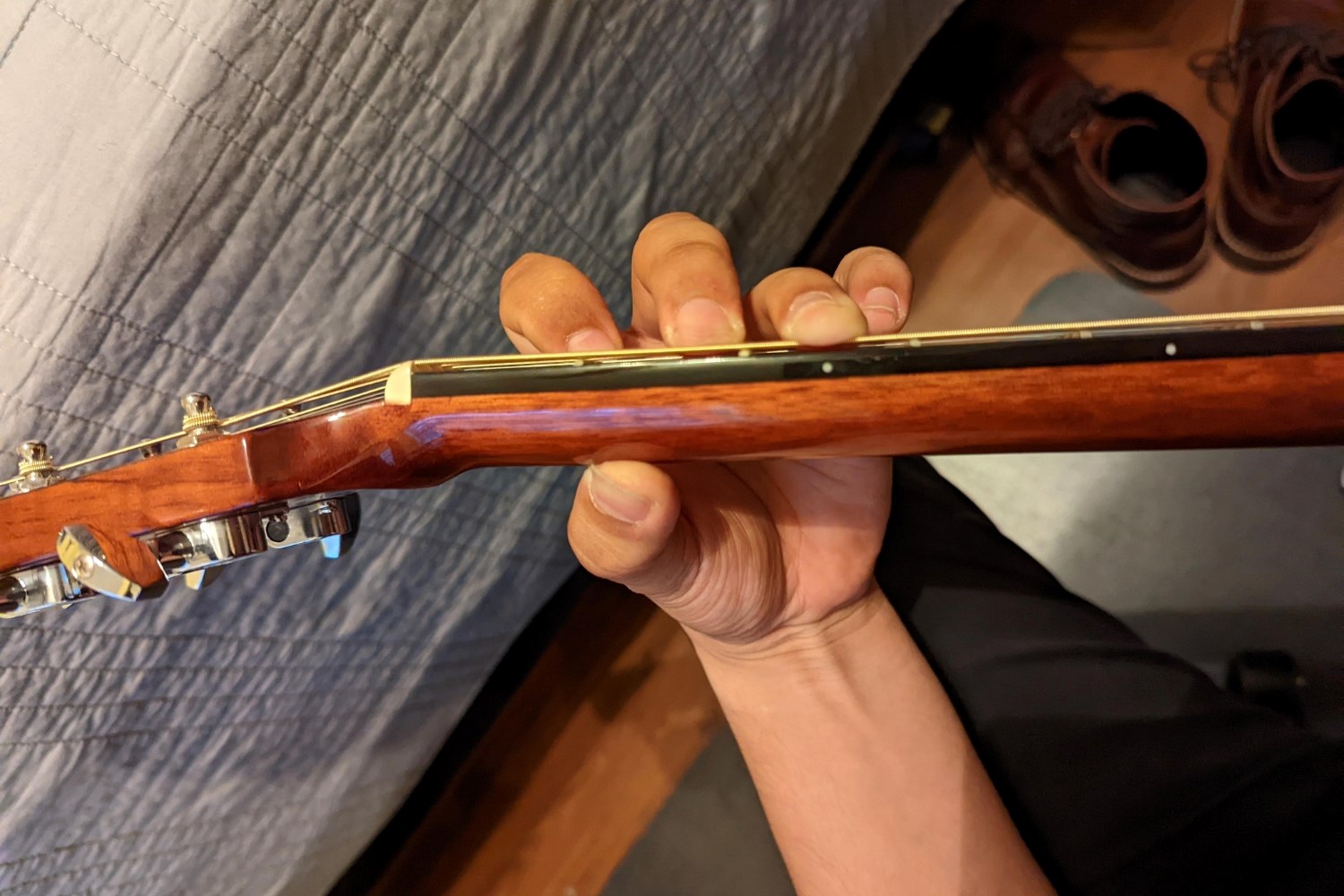Home>Music>Master The G7 Chord On Guitar With These Easy Steps!


Music
Master The G7 Chord On Guitar With These Easy Steps!
Published: February 13, 2024
Learn how to master the G7 chord on guitar with these easy steps! Enhance your music skills and play like a pro with our expert tips. Unlock the secrets of the G7 chord today!
(Many of the links in this article redirect to a specific reviewed product. Your purchase of these products through affiliate links helps to generate commission for Noodls.com, at no extra cost. Learn more)
Table of Contents
Introduction
Learning to play the guitar is an exciting journey that opens up a world of musical possibilities. Whether you're a beginner or an experienced player, mastering essential chords is crucial for expanding your repertoire and enhancing your musical prowess. Among the fundamental chords every guitarist should know is the G7 chord. This versatile and expressive chord adds depth and character to your playing, making it a valuable addition to your skill set.
The G7 chord is a staple in various musical genres, including blues, jazz, rock, and folk. Its distinctive sound and harmonic richness make it a favorite among musicians seeking to infuse their compositions with soulful resonance. By mastering the G7 chord, you'll not only elevate your playing but also gain a deeper understanding of chord structures and progressions.
In this comprehensive guide, we'll delve into the intricacies of the G7 chord, providing you with easy-to-follow steps to conquer this essential element of guitar playing. From understanding the theory behind the G7 chord to perfecting your finger placement and exploring different strumming techniques, this guide will equip you with the knowledge and skills needed to wield the G7 chord with confidence and finesse.
Whether you're aiming to jam with fellow musicians, write captivating melodies, or simply enrich your musical journey, mastering the G7 chord will undoubtedly amplify your guitar playing experience. So, grab your guitar, tune your strings, and let's embark on a fulfilling exploration of the G7 chord, unlocking its potential to elevate your musical expression.
Understanding the G7 Chord
The G7 chord is a fundamental component of guitar playing, renowned for its rich and versatile sound. Comprising the notes G, B, D, and F, the G7 chord is classified as a dominant seventh chord, denoted as G7. Understanding the theory behind this chord is essential for harnessing its expressive potential and integrating it seamlessly into your playing.
In music theory, the G7 chord is constructed using the root note G, the major third B, the perfect fifth D, and the minor seventh F. This combination of intervals creates a distinct blend of tension and resolution, lending the G7 chord its characteristic allure. The dominant seventh quality of the G7 chord infuses it with a sense of anticipation, making it a pivotal element in harmonic progressions and cadences.
When played on the guitar, the G7 chord is typically formed by placing the index finger on the first fret of the high E string, the middle finger on the second fret of the A string, and the ring finger on the third fret of the low E string. This finger placement produces a resonant and full-bodied sound that embodies the essence of the G7 chord.
Moreover, the G7 chord serves as a gateway to understanding the principles of chord construction and harmonic relationships. By grasping the nuances of the G7 chord, aspiring guitarists can expand their knowledge of chord voicings, inversions, and substitutions, empowering them to navigate the fretboard with confidence and creativity.
In essence, the G7 chord represents a harmonious blend of tension and resolution, offering a myriad of melodic possibilities for guitarists to explore. Its significance extends beyond individual notes and fret positions, encapsulating the essence of musical expression and emotive resonance. As we delve deeper into the intricacies of the G7 chord, we will unravel its potential to elevate your playing and infuse your musical endeavors with depth and sophistication.
Basic Finger Placement
Mastering the basic finger placement for the G7 chord is a pivotal step in your guitar journey. This foundational chord requires precise finger positioning to produce its distinctive and resonant sound. To achieve this, let's break down the finger placement into a step-by-step guide that will enable you to form the G7 chord with ease and accuracy.
-
Start by positioning your guitar properly, ensuring that it is comfortably seated on your lap or secured with a strap. This foundational step sets the stage for optimal finger mobility and fretboard navigation.
-
Place your fretting hand on the guitar neck, with your thumb resting comfortably behind the neck for support and stability. This position allows for greater control and dexterity when forming chords.
-
Begin forming the G7 chord by focusing on the fretting hand's finger placement. Position your index finger on the first fret of the high E string, which is the string closest to the ground when holding the guitar in playing position.
-
Next, place your middle finger on the second fret of the A string, which is the second thickest string on the guitar. This precise placement is crucial for achieving the harmonic richness and resonance characteristic of the G7 chord.
-
Finally, position your ring finger on the third fret of the low E string, the thickest string on the guitar. This strategic placement completes the G7 chord formation, culminating in a harmonious blend of notes that define the chord's expressive quality.
-
Ensure that each finger is placed behind the fret, allowing for clear and sustained notes when strummed. Maintaining proper finger placement is essential for producing a clean and resonant sound, free from muffled or muted notes.
-
Once your fingers are in position, check for any buzzing or muted strings by plucking each string individually. Make necessary adjustments to your finger placement to eliminate any unwanted buzzing or muted tones, ensuring that each note rings out clearly.
By meticulously following these steps and honing your finger placement, you will gradually develop muscle memory and finger strength, enabling you to effortlessly transition into and out of the G7 chord. Consistent practice and attention to detail will refine your finger placement, allowing you to unleash the full potential of the G7 chord and integrate it seamlessly into your musical repertoire.
Strumming Techniques
Mastering the art of strumming is essential for bringing the G7 chord to life with dynamic and rhythmic flair. By honing your strumming techniques, you can infuse your playing with nuance, emotion, and captivating rhythm. Whether you're aiming for a soulful ballad, a lively folk tune, or an energetic rock anthem, the way you strum the G7 chord can profoundly impact its sonic character.
Downward Strumming
Begin by familiarizing yourself with the foundational downward strumming technique. This involves sweeping your pick or fingers downward across the strings in a fluid motion, producing a resonant and full-bodied sound. When strumming the G7 chord in a downward motion, focus on maintaining a consistent rhythm and applying gentle pressure to the strings. This technique allows you to unleash the chord's expressive potential, creating a captivating sonic foundation for your musical endeavors.
Upward Strumming
Incorporating upward strumming into your repertoire adds depth and versatility to your playing. By reversing the motion and strumming upward across the strings, you can introduce a contrasting texture and tonal variation to the G7 chord. Upward strumming complements downward strumming, offering a nuanced approach to shaping the chord's sonic resonance. Experiment with the angle and intensity of your upward strumming to discover the ideal balance that enhances the G7 chord's expressive range.
Strumming Patterns
Exploring diverse strumming patterns empowers you to craft compelling rhythmic accompaniments for the G7 chord. From simple, steady patterns to intricate and syncopated rhythms, the possibilities are endless. Experiment with variations such as the classic "down, down-up, up-down-up" pattern or create your own unique sequences to imbue the G7 chord with rhythmic vitality. Adapting your strumming patterns to suit different musical styles and tempos allows you to unlock the G7 chord's versatility and adaptability, enriching your musical expression.
Dynamics and Articulation
Beyond the physical motion of strumming, paying attention to dynamics and articulation elevates your interpretation of the G7 chord. Embrace the interplay of soft and loud strums, infusing your playing with expressive dynamics that evoke emotion and intensity. Additionally, varying the articulation of your strums, from gentle and flowing to crisp and percussive, adds depth and dimension to the G7 chord, amplifying its impact within your musical compositions.
Incorporating Fingerstyle Techniques
For those inclined towards fingerstyle playing, integrating fingerpicking techniques with the G7 chord opens up a world of melodic possibilities. Experiment with plucking individual strings or crafting intricate fingerstyle patterns to embellish the G7 chord with melodic motifs and rhythmic intricacies. By blending fingerstyle techniques with traditional strumming, you can expand the sonic palette of the G7 chord, infusing it with a captivating fusion of melody and rhythm.
Embracing Versatility
Ultimately, mastering strumming techniques for the G7 chord is about embracing versatility and creativity. As you refine your strumming prowess, allow your musical intuition to guide you, exploring new textures, rhythms, and expressive nuances. Whether you're strumming with vigor and exuberance or delicately caressing the strings, the G7 chord responds to your artistic interpretation, inviting you to unleash its boundless potential across diverse musical genres and artistic expressions.
Incorporating these strumming techniques into your practice regimen will not only enhance your command of the G7 chord but also enrich your overall guitar playing experience. Embrace the rhythmic tapestry that strumming techniques offer, and let the G7 chord become a vibrant cornerstone of your musical journey.
Common Variations
Exploring common variations of the G7 chord opens up a world of creative possibilities, allowing you to infuse your playing with diverse textures and tonal nuances. While the standard G7 chord forms the foundation of your repertoire, incorporating variations adds depth and versatility to your musical expression. Whether you're seeking to embellish your compositions with subtle embellishments or unleash bold reinterpretations of the G7 chord, these variations offer a spectrum of sonic potential.
G7/F Chord
The G7/F chord, also known as G7 with an F bass, introduces a captivating harmonic twist to the traditional G7 voicing. To play this variation, simply place your thumb or index finger on the first fret of the low E string, effectively adding an F note to the chord. This subtle alteration imbues the G7 chord with a rich, resonant quality, creating a sense of depth and tension. The G7/F variation serves as a compelling transition chord and can add a touch of intrigue to your chord progressions.
G7/G Chord
Incorporating the G7/G chord involves emphasizing the G note within the chord structure, resulting in a bold and assertive tonal character. To achieve this variation, refrain from fretting the low E string, allowing it to ring open and resonate as a G note. This modification accentuates the chord's root note, infusing your playing with a robust and commanding presence. The G7/G variation is particularly effective in creating a sense of resolution and stability within your musical arrangements.
Read more: Master The BTS Fan Chant In 5 Easy Steps!
G7/B Chord
The G7/B chord introduces a unique tonal color by emphasizing the B note within the chord voicing. To form this variation, refrain from fretting the low E string and instead focus on accentuating the second fret of the A string, which produces the B note. This alteration imbues the G7 chord with a sense of brightness and warmth, offering a refreshing sonic variation that can elevate your compositions. The G7/B variation serves as a compelling harmonic embellishment, adding a touch of sophistication to your chord progressions.
G7/D Chord
Embracing the G7/D chord involves highlighting the D note within the chord structure, resulting in a resonant and harmonically rich variation. To play this variation, refrain from fretting the low E string and instead emphasize the open D string, allowing it to ring out freely. This modification infuses the G7 chord with a sense of openness and expansiveness, creating a captivating tonal landscape within your musical arrangements. The G7/D variation serves as a compelling harmonic pivot, offering a seamless transition and adding depth to your chord progressions.
By incorporating these common variations into your repertoire, you can expand your sonic palette and infuse your playing with captivating tonal nuances. Whether you're crafting intricate chord progressions, embellishing melodic compositions, or exploring improvisational techniques, these variations offer a wealth of creative potential, empowering you to redefine the expressive range of the G7 chord within your musical endeavors.
Practice Tips
Mastering the G7 chord on the guitar requires dedicated practice and a strategic approach to skill development. Here are valuable practice tips to guide you on your journey to proficiency:
-
Consistent Repetition: Incorporate the G7 chord into your daily practice routine. Consistent repetition is key to reinforcing muscle memory and finger dexterity, enabling you to form the chord effortlessly.
-
Chord Transition Exercises: Practice transitioning to and from the G7 chord in various chord progressions. This helps you seamlessly integrate the G7 chord into your playing and enhances your overall fluency on the fretboard.
-
Metronome Practice: Utilize a metronome to practice strumming the G7 chord in rhythm. Gradually increase the tempo as you build confidence, ensuring precision and timing in your chord execution.
-
Finger Strength Exercises: Engage in finger strength exercises to enhance your fretting hand's agility and endurance. This strengthens your ability to form the G7 chord with clarity and sustain its resonance.
-
Song Application: Learn songs that prominently feature the G7 chord. Applying the chord in real musical contexts enhances your understanding of its versatility and fosters a deeper connection with its expressive potential.
-
Ear Training: Develop your ear by identifying the G7 chord in songs across different genres. This sharpens your musical intuition and facilitates quicker chord recognition during play.
-
Creative Exploration: Experiment with improvisation and embellishments using the G7 chord. This fosters creativity and expands your musical vocabulary, allowing you to personalize your playing style.
-
Recording Sessions: Record your practice sessions to track your progress and identify areas for improvement. Listening back to your recordings provides valuable insights into your playing dynamics and articulation.
-
Seek Feedback: Share your G7 chord practice with fellow musicians or mentors. Constructive feedback and guidance can offer fresh perspectives and help refine your technique.
-
Mindful Rest and Recovery: Allow for adequate rest periods to prevent strain and fatigue. Balancing practice with rest ensures sustained progress and prevents overexertion.
By integrating these practice tips into your guitar routine, you can cultivate a solid foundation in mastering the G7 chord. Embrace the journey of skill development with patience and persistence, and celebrate the incremental improvements that contribute to your overall growth as a guitarist.
Conclusion
In conclusion, mastering the G7 chord on the guitar is a transformative endeavor that empowers musicians to expand their creative horizons and elevate their musical expression. Through a comprehensive understanding of the G7 chord's theory, precise finger placement, nuanced strumming techniques, and exploration of common variations, guitarists can harness the chord's versatile and emotive qualities to enrich their playing across diverse genres and musical contexts.
The journey of mastering the G7 chord extends beyond technical proficiency, encompassing a profound exploration of musicality and artistic interpretation. As guitarists delve into the intricacies of the G7 chord, they cultivate a deeper appreciation for harmonic tension and resolution, rhythmic dynamics, and the interplay of tonal colors. This holistic approach to mastering the G7 chord fosters a sense of musical fluency and empowers musicians to infuse their compositions with depth, emotion, and captivating sonic textures.
Furthermore, the practice tips provided offer a strategic roadmap for skill development, guiding guitarists through focused and purposeful practice sessions. By integrating consistent repetition, chord transition exercises, metronome practice, and creative exploration, musicians can cultivate a strong foundation in mastering the G7 chord while nurturing their musical intuition and expressive capabilities.
Ultimately, the G7 chord serves as a gateway to artistic exploration and self-expression, inviting guitarists to embark on a fulfilling journey of musical discovery. Whether used as a foundational chord in a timeless ballad, a soulful accompaniment in a blues composition, or a dynamic element in a jazz improvisation, the G7 chord resonates with emotive depth and harmonic allure.
As guitarists embrace the nuances of the G7 chord, they unlock a world of melodic possibilities and rhythmic intricacies, shaping their musical narratives with authenticity and creativity. The G7 chord becomes not only a technical achievement but a catalyst for artistic growth, empowering musicians to craft compelling melodies, captivating harmonies, and evocative musical experiences.
In essence, mastering the G7 chord transcends the realm of technical proficiency, evolving into a journey of artistic self-discovery and musical expression. By embracing the inherent beauty and versatility of the G7 chord, guitarists embark on a transformative odyssey that enriches their playing, amplifies their creativity, and imbues their musical endeavors with enduring resonance and emotive depth.












